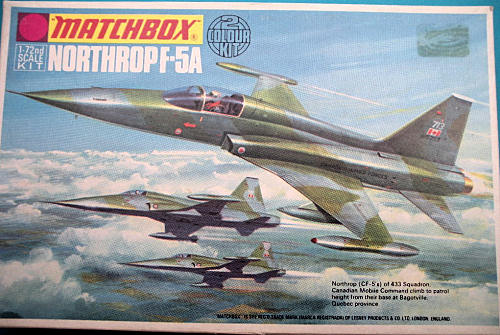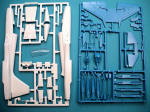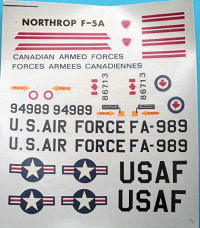
| KIT #: | PK-12 (1973) |
| PRICE: | $ Currently out of production |
| DECALS: | Two options |
| REVIEWER: | Victor Scheuerman |
| NOTES: |

| HISTORY |
The ‘Freedom
Fighter’ was the outcome of a 1954 decision by Northrop to produce a cheaper
lightweight fighter that could challenge the performance of more expensive
rivals. The end result, the F-5A (single seat) was initially exported as Mutual
Aid Program equipment to Greece, Turkey, Nationalist China, Philippines, Iran
and South Korea.
The F-5 was also
widely exported with examples being used by Botswana, Canada, Ethiopia, Jordan,
Libya, Morocco, Netherlands, Norway, Spain, Thailand, South Vietnam and
Venezuela. Both the F-5A and F-5B
would also be produced under license in both
Northrop’s initial models used two General Electric J85-GE-13 turbojets that would result in a maximum speed of 925 M.P.H. at 36,000 feet. The F-5 was always a lightweight as it could only carry could an external load of 6,200 pounds of ordinance in addition to its two 20 MM cannons. A recce version was also made that had a number of cameras in a new flattened nose. One of the criticisms of this basic jet is its short range and because of this, it almost always carries its signature ‘Coke-bottle’ wing-tip tanks.
| THE KIT |
 Matchbox’s
version of this widely exported fighter encompasses a total of 41 parts
including a clear one-piece canopy. The external surface is a combination of
both raised (petit) and engraved panel lines with the latter not quite their
normal ‘trench’ depths. A very basic cockpit is offered with an ejection seat
that is actually fairly close to the real one that holds a well sculptured
pilot.
Matchbox’s
version of this widely exported fighter encompasses a total of 41 parts
including a clear one-piece canopy. The external surface is a combination of
both raised (petit) and engraved panel lines with the latter not quite their
normal ‘trench’ depths. A very basic cockpit is offered with an ejection seat
that is actually fairly close to the real one that holds a well sculptured
pilot.
External stores
include two bombs for the underwing pylons and the option of Sidewinders (poor
interpretations) or the fuel tanks (nicely captures their unique shape) for the
wing tips. Matchbox did a good job on the landing gear with the main struts
having their almost scale retraction arms molded in place and the wheels feature
some detail. However, as normal, the gear doors are rather thick and should be
replaced with card or sanded thinner.
 The nine
assembly steps are well illustrated with detail colour notes offered at the end.
There are two decal options and the decals are well printed and still look
useable.
The nine
assembly steps are well illustrated with detail colour notes offered at the end.
There are two decal options and the decals are well printed and still look
useable.
First option is a
CF-5 of 433 (Porcupine) Squadron of the Canadian Forces in the initial
camouflage of dark green and grey over light grey. Marking are limited to the
small size high-viz national marking and the bilingual titles in black on the
fuselage sides. The second Freedom Fighter is an American in a sprayed aluminum
finish and the full national markings in high-viz. Stenciling is limited to the
major items on the cockpit area and the red warning stripes on the aft fuselage.
| CONCLUSIONS |
While the ESCI/Italeri is a much better F-5 in this scale, the Matchbox kit is in second place in my opinion after having built the alternatives over the years. This Matchbox kit is an easy build that looks good when completed and could be the basis to show off the plethora of finishes carried by this widely exported light weight.
December 2008
If you would like your product reviewed fairly and quickly, please contact me or see other details in the Note to Contributors.